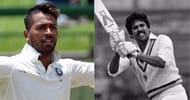Fans, the media and cricket experts love to compare players of the current generation with the greats of the past. Questions like "Is Hardik Pandya the new Kapil Dev?" or "Is Cheteshwar Pujara the new Wall in the Indian batting lineup?" or "Who are the new Fab Four of Indian cricket team?" have no relevance in the sport, and yet they have been asked innumerable times.
Even the current players time and again have spoken out against being compared with yesteryear greats.
Here are three reasons why comparing players from different generations should be avoided by the fans, media and cricket experts:
#1 Changed scenarios
While comparing the players from different generations, people often forget about the changes which have taken place in the game. Be it the rules, the dimensions of the ground or the infrastructure in place, everything has evolved so much so that no one can actually imagine how certain players of the past generations would have played in today's time, or how the players from this generation would have played in the past scenarios.
For example, imagine a situation where a young Sachin Tendulkar got caught at the boundary line in the 1990s in an attempt to hit a six over the long boundaries used at that time. However, with the shortened boundaries in today's times, the same shot could have yielded six runs.
Nowadays it just takes a matter of 2-3 matches to do a complete SWOT analysis of a new (unknown) player with the extensive use of videotapes. That was not possible in earlier years, as figuring out how to get a batsman out was completely based on the bowler's analysis of a particular batsman.
In fact, one more stark contrast in brought forth by the evolution of the game is the support staff. Today, a Head Coach is assisted by specialist coaches for batting, bowling and fielding, not to forget the physios and nutritionists among others. If the same facilities were given to some of the yesteryear greats, who knows what they would have achieved in their careers.
#2 Increased pressure on current generation

Comparisons with the legends of the game after 3-4 performances have become a norm these days. But that has more often than not resulted in either the youngsters forgetting their own game and trying to emulate the legend they are being compared to, or in order to carve out their own name, try to change their game so that they are seen differently.
Whatever the scenario may be, comparisons have led to many youngsters not fulfilling their potential, and instead succumbing to the pressure of expectations. Those who actually manage to make the cut always acknowledge the importance of sticking to their own game and not letting the comparisons distract them.
#3 Demeaning to the legends' achievements
The status of "legend" or "great" is given to a player after consistent match-winning performances, which are a result of years of effort and hard work. To compare them with someone who has just started his career is very demeaning to their achievements.
All youngsters try and emulate their heroes / role models in the way they play, but over a period of time they do manage to analyze their own game and make their name in the sport. Thus, no matter how similar a player's game is to any past player, we should not jump to conclusions and compare them. Instead, we should give current players the time and space to showcase their talent and make their own name, and not hope for them to be the second coming of anyone.
Brand-new app in a brand-new avatar! Download CricRocket for fast cricket scores, rocket flicks, super notifications and much more! 🚀☄️
